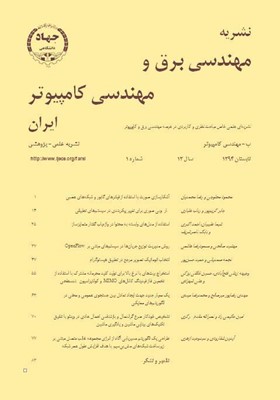چارچوبی صوری برای تغییر پیکربندی در سیستمهای تطبیقی
محورهای موضوعی : مهندسی برق و کامپیوترجابر کریمپور 1 , رباب علیاری 2 *
1 - دانشگاه تبریز
2 - دانشگاه تبریز
کلید واژه: آداپتور پیکربندی پویا سیستمهای تطبیقی روشهای صوری,
چکیده مقاله :
امروزه از سیستمهای پیشرفته انتظار میرود که بتوانند خود را با شرایط محیطی و اتفاقات غیر منتظره سازگار کنند. اولین شرط برای چنین سیستمهایی سازگارشدن آنها با توجه به نیازهای مشتری، داشتههای خود و محیطی که در آن قرار دارند است و باید هنگام مواجه با مشکل یا درخواست غیر منتظره به آن جواب دهند. در راهکارهای تطابقسازی سعی شده با استفاده از قرارداد تطابق و تغییر پیکربندی مجدد، سیستم با شرایط وفق داده شود به طوری که این تغییر پیکربندی مجدد به دور از چشم سرویسگیرنده و گاهی در حین اجرای عملیات انجام گردد و طراحان سیستم را نیز از دخالت مستقیم در امور داخلی مربوط به کارگزار منع کند. شایان ذکر است گاهی اوقات همین روشهای تطابقسازی نقش زیادی در استفاده مجدد مؤلفهها برای ایجاد سیستمهای جدید یا بالابردن سطح سیستمهای قدیمی با استفاده از مؤلفههای موجود را نیز ایفا میکنند. این مقاله با روشهای فرمال سعی در ایجاد سیستمی دارد که توان سازگاری با محیط را داشته باشد و در کنار آن، مشکلات ناشی از پیچیدگی را نیز تا حدی میکاهد. برای این کار ابتدا سیستم به وسیله یک مدل ریاضی نمایش داده شده و سپس از روی سیستم مدلشده، قرارداد تطابق و درخواست مشتری یک فرم جدید به نام آداپتور طراحی میشود. بعد از ایجاد آداپتور تمام پیکربندیها و تراکنشهای بین سیستم و مشتری از طریق آن انجام میگردد و آداپتور مسئول هماهنگسازی اجزای داخلی سیستم میباشد. همچنین برای جلوگیری از پیچیدگی، از مفهوم شبکه و سرویسهای سلسله مراتبی برای ایجاد شبکهای از آداپتورها استفاده شده است.
Today's advanced systems are expected to be able to adapt to environmental conditions and unpredictable situations. The first requirement for such systems is to adjust them according to customer needs, their own ability and operational environment and they should be able to answer when faced with problem and unexpected request. Software adaptation techniques try to cope, with adaptation contracts and reconfiguration capabilities. Also these reconfigurations should be performed out of the sight of client and sometimes during the operation so that prohibit system designers from direct involvement in the internal affairs of clients. Sometimes these adaptation techniques have an impressive role in reusing components for making new systems or improving old ones. Thins paper try to create a system that can be adapted to the environment and besides it also reduces the complexity problem. To do so, at first we use a formal model to represent the whole system and then, build a mathematical model called adaptor based on adaptation contract and client requests. After creation of the adaptor, the all configuration and transactions between the client and system are done through the adaptors and Adaptors are responsible for coordinating the internal system components. Also, to avoid complexity, the concept of hierarchical networks and services are used for building the networks of adaptors.
[1] A. Colman, Role - Oriented Adaptive Design, Ph. D. Thesis, Swinburne University, Melbourn, Australia, 2007.
[2] T. Batista, A. Joolia, and G. Coulson, "Managing Dynamic Reconfiguration in Component - Based Systems," in Proc. 2nd European WorkShop on Software Architectures, pp. 1-17, Pisa, Italy, 13-14 Jun. 2005.
[3] J. Aldrich, C. Chambers, and D. Notkin, "ArchJava: connecting software architecture to implementation," in Proc. of the 24th Int. Conf. on Software Engineering ICSE'04, pp. 187-197, Orlando, US, May 2004.
[4] I. Sander and A. Jantsch, "Modelling adaptive system in ForSyDe," Electronic Notes in Theorical Computer Science, vol. 200, no. 2, pp. 39-54, Feb. 2008.
[5] I. Georgiadis, J. Magee, and J. Kramer, "Self - organising software architecture for distributed systems," in Proc. of the 1st Workshop on Self - Healing Systems, WOSS'02, pp. 33-38, New York, US, 18-19 Nov. 2002.
[6] D. Garlen, S. Cheng, A. Huang, B. Schmerl, and P. Streenkiste, "Rainbow: architecture-based self-adaptation with reusable infrastructure," Computer, vol. 37, no. 10, pp. 46-54, Oct. 2004.
[7] D. Garlan, V. Poladian, B. Schmerl, and J. P. Sousa, "Task - based self - adaptation," in Proc. of the 1st ACM SIGSOFT Workshop on Self - Managed Systems, pp. 54-57, California, 31 Oct.-1 Nov. 2004.
[8] N. Khakpour, S. Jalili, C. Talcott, M. Sirjani, and M. Mousavi, "Formal modeling of evolving self - adaptive systems," J. of Science of Computer Programming, vol. 78, no. 1, pp. 3-26, Nov. 2011.
[9] R. Bruni, A. Corradini, F. Gadducci, A. Lluch, and A. Vandin, "A conceptual framework for adaptation," Lecture Notes in Computer Science, vol. 7212, pp. 240-254, 2012.
[10] A. Cansado, J. Cubo, G. Salaun, and C. Canal, "A formal framework for structural reconfiguration of component under behavioral adaptation," Electronic Notes in Theorical Computer Science, vol. 263, pp. 95-110, 3 Jun. 2011.
[11] J. Camara, G. Salaun, C. Canal, and M. Ouederni, "Interactive specification and verification of behavioural adaptation contracts," Information and Software Technology, vol. 54, no. 7, pp. 701-723, Jul. 2012.
[12] Y. Jin, C. Lakos, and R. Esser, "Modular consistency analysis of component-based designs," Journal of Research and Practice in Information Technolog, vol. 36, no. 3, pp. 186-208, Aug. 2004.
[13] A. Arnold, Finite Transition Systems: Semantics of Communicating Systems, Prentice - Hall, 1994.
[14] M. U. Iftikhar and D. Weyns, "A case study on formal verification of self - adaptive behaviors in a decentralized system," in Proc. 11th Int. Workshop on Foundations of Coordination Languages and Self Adaptation, FOCLASA'12, pp 45-62, Aug. 2012.

